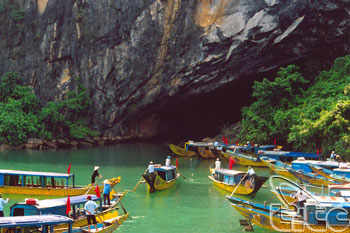Nature has bestowed a diversity of natural landscapes on Quang Binh with plains, mountains, lakes and islands. The province is located at the intersection of the north-south railway, Highway 1A, and the Ho Chi Minh Highway as well as roads connected to Laos. Quang Binh has many advantages and the potential for diversified and sustainable tourism development.
 Awaking potential
Awaking potential
Quang Binh is closely linked to the Bau Tro culture which dates back 4,000 years. The province is also keeping several sites including Quang Binh Quan, Luy Thay and Trinh-Nguyen palaces and famous historical battlegrounds in the struggle against the French and Americans, such as Cu Nam, Canh Duong, Cha Lo, Cong Troi, Long Dai and remnants of the Ho Chi Minh Trail.
Quang Binh is also a place of convergence for the cultural heritages of the north central regions. Therefore, the province has retained distinctive culture features, expressed through its festivals, such as a traditional swimming festival, the Moon Festival in Minh Hoa District, the Dap Trong Ma Coong Festival in Trach District and the its vibrant folk songs.
The Nhat Le River flows through the heart of the city; and the city benefits from its nearby surrounding canals and Nhat Le, Quang Phu, Bao Ninh, and Da Nhay beaches and Bang hot mineral spring.
The most striking tourism location in the province is Phong Nha-Ke Bang, recognized as UNESCO World Heritage Site with outstanding geological features formed over 400 million years, containing more than 300 small and large caves.
Together with the amazing cave system, the Trooc, Chay and Son rivers in the Phong Nha-Ke Bang region have created a beautiful water-color picture. When considering all these major assets, Quang Binh Province has favorable conditions to develop tourism and serve a variety of different visitors.
Blending diversity and specific features
Quang Binh has prioritized investment in building infrastructure for tourism in recent years, such as roads, power lines, water supplies, ports and airports. Tourist accommodation facilities has been also upgraded, renovated and built to a high standard.
Areas and routes have been planned; with historical cultural sites restored and embellished and festivals provided with a facelift to create more unique and attractive tourism products. In addition, local tourism staff have improved their professional knowledge. Tourists numbers to Quang Binh have rapidly grown in recent years. In the 2006-2010 period, the total number of tourists to Quang Binh reached over 3,183 million, an average increase of 12.9 percent per year. This figure totaled nearly one million in 2011, including 18,000 international tourists with total revenue of VND424 billion.
In terms of Quang Binh's tourism development until 2015, the province is determined focusing on effectively exploiting its advantages to develop tourism into a key economic sector, contributing to the socioeconomic growth and economic restructuring in a drive towards increasing tourism and services as a proportion of GDP; creating jobs and increasing local incomes, raising budget revenues; and setting the foundation for the development of other industries.
In addition to developing tourism in a sustainable way, preserving the national cultural character and ecological system and protecting environment, ensuring security and social stability, Quang Binh Province's tourism sector has raised awareness among the community and built mechanisms and policies to encourage all economic sectors and international organizations to invest in tourism development in order to improve the quality and diversify of products available in order to create unique and highly competitive tourism products.
Together with the active participation in activities under the national action program on tourism, Quang Binh Province's tourism sector will also build strong links with localities in Laos and northeast Thailand to promote tourism development in the center of Vietnam and the East-West Corridor.
Quang Binh will concentrate on developing key tourist features of the province in the near future, such as cave tourism, cultural-historical tourism and ecological tourism.
Quang Binh's tourism sector will also focus on building unique tourism products to enhance competitiveness, contributing to sustainable tourism development, improving the status of Quang Binh as a tourist destination and develop Quang Binh into an attractive and unique destination for both domestic and foreign tourists.